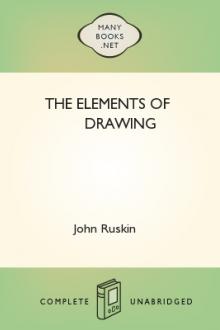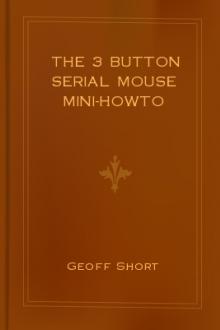The Elements of Drawing by John Ruskin (smart books to read .txt) 📕

xii. One task, however, of some difficulty, the student will find I have not imposed upon him: namely, learning the laws of perspective. It would be worth while to learn them, if he could do so easily; but without a master's help, and in the way perspective is at present explained in treatises, the difficulty is greater than the gain. For perspective is not of the slighte
Read free book «The Elements of Drawing by John Ruskin (smart books to read .txt) 📕» - read online or download for free at americanlibrarybooks.com
- Author: John Ruskin
- Performer: -
Read book online «The Elements of Drawing by John Ruskin (smart books to read .txt) 📕». Author - John Ruskin
228. Sometimes this alternation is merely a reversal of contrasts; as that, after red has been for some time on one side, and blue on the other, red shall pass to blue's side and blue to red's. This kind of alternation takes place simply in four-quartered shields; in more subtle pieces of treatment, a little bit only of each color is carried into the other, and they are as it were dovetailed together. One of the most curious facts which will impress itself upon you, when you have drawn some time carefully from Nature in light and shade, is the appearance of intentional artifice with which contrasts of this alternate kind are produced by her; the artistry with which she will darken a tree trunk as long as it comes against light sky, and throw sunlight on it precisely at the spot where it comes against a dark hill, and similarly treat all her masses of shade and color, is so great, that if you only follow her closely, every one who looks at your drawing with attention will think that you have been inventing the most artificially and unnaturally delightful interchanges of shadow that could possibly be devised by human wit.
229. You will find this law of interchange insisted upon at length by Prout in his Lessons on Light and Shade: it seems of all his principles of composition to be the one he is most conscious of; many others he obeys by instinct, but this he formally accepts and forcibly declares.
The typical purpose of the law of interchange is, of course, to teach us how opposite natures may be helped and strengthened by receiving each, as far as they can, some impress or reflection, or imparted power, from the other.
8. THE LAW OF CONSISTENCY.
230. It is to be remembered, in the next place, that while contrast exhibits the characters of things, it very often neutralizes or paralyzes their power. A number of white things may be shown to be clearly white by opposition of a black thing, but if we want the full power of their gathered light, the black thing may be seriously in our way. Thus, while contrast displays things, it is unity and sympathy which employ them, concentrating the power of several into a mass. And, not in art merely, but in all the affairs of life, the wisdom of man is continually called upon to reconcile these opposite methods of exhibiting, or using, the materials in his power. By change he gives them pleasantness, and by consistency value; by change he is refreshed, and by perseverance strengthened.
231. Hence many compositions address themselves to the spectator by aggregate force of color or line, more than by contrasts of either; many noble pictures are painted almost exclusively in various tones of red, or gray, or gold, so as to be instantly striking by their breadth of flush, or glow, or tender coldness, these qualities being exhibited only by slight and subtle use of contrast. Similarly as to form; some compositions associate massive and rugged forms, others slight and graceful ones, each with few interruptions by lines of contrary character. And, in general, such compositions possess higher sublimity than those which are more mingled in their elements. They tell a special tale, and summon a definite state of feeling, while the grand compositions merely please the eye.
232. This unity or breadth of character generally attaches most to the works of the greatest men; their separate pictures have all separate aims. We have not, in each, gray color set against somber, and sharp forms against soft, and loud passages against low: but we have the bright picture, with its delicate sadness; the somber picture, with its single ray of relief; the stern picture, with only one tender group of lines; the soft and calm picture, with only one rock angle at its flank; and so on. Hence the variety of their work, as well as its impressiveness. The principal bearing of this law, however, is on the separate masses or divisions of a picture: the character of the whole composition may be broken or various, if we please, but there must certainly be a tendency to consistent assemblage in its divisions. As an army may act on several points at once, but can only act effectually by having somewhere formed and regular masses, and not wholly by skirmishers; so a picture may be various in its tendencies, but must be somewhere united and coherent in its masses. Good composers are always associating their colors in great groups; binding their forms together by encompassing lines, and securing, by various dexterities of expedient, what they themselves call "breadth:" that is to say, a large gathering of each kind of thing into one place; light being gathered to light, darkness to darkness, and color to color. If, however, this be done by introducing false lights or false colors, it is absurd and monstrous; the skill of a painter consists in obtaining breadth by rational arrangement of his objects, not by forced or wanton treatment of them. It is an easy matter to paint one thing all white, and another all black or brown; but not an easy matter to assemble all the circumstances which will naturally produce white in one place, and brown in another. Generally speaking, however, breadth will result in sufficient degree from fidelity of study: Nature is always broad; and if you paint her colors in true relations, you will paint them in majestic masses. If you find your work look broken and scattered, it is, in all probability, not only ill composed, but untrue.
233. The opposite quality to breadth, that of division or scattering of light and color, has a certain contrasting charm, and is occasionally introduced with exquisite effect by good composers.[70] Still it is never the mere scattering, but the order discernible through this scattering, which is the real source of pleasure; not the mere multitude, but the constellation of multitude. The broken lights in the work of a good painter wander like flocks upon the hills, not unshepherded, speaking of life and peace: the broken lights of a bad painter fall like hailstones, and are capable only of mischief, leaving it to be wished they were also of dissolution.
9. THE LAW OF HARMONY.
234. This last law is not, strictly speaking, so much one of composition as of truth, but it must guide composition, and is properly, therefore, to be stated in this place.
Good drawing is, as we have seen, an abstract of natural facts; you cannot represent all that you would, but must continually be falling short, whether you will or no, of the force, or quantity, of Nature. Now, suppose that your means and time do not admit of your giving the depth of color in the scene, and that you are obliged to paint it paler. If you paint all the colors proportionately paler, as if an equal quantity of tint had been washed away from each of them, you still obtain a harmonious, though not an equally forcible, statement of natural fact. But if you take away the colors unequally, and leave some tints nearly as deep as they are in Nature, while others are much subdued, you have no longer a true statement. You cannot say to the observer, "Fancy all those colors a little deeper, and you will have the actual fact." However he adds in imagination, or takes away, something is sure to be still wrong. The picture is out of harmony.
235. It will happen, however, much more frequently, that you have to darken the whole system of colors, than to make them paler. You remember, in your first studies of color from Nature, you were to leave the passages of light which were too bright to be imitated, as white paper. But, in completing the picture, it becomes necessary to put color into them; and then the other colors must be made darker, in some fixed relation to them. If you deepen all proportionately, though the whole scene is darker than reality, it is only as if you were looking at the reality in a lower light: but if, while you darken some of the tints, you leave others undarkened, the picture is out of harmony, and will not give the impression of truth.
236. It is not, indeed, possible to deepen all the colors so much as to relieve the lights in their natural degree, you would merely sink most of your colors, if you tried to do so, into a broad mass of blackness: but it is quite possible to lower them harmoniously, and yet more in some parts of the picture than in others, so as to allow you to show the light you want in a visible relief. In well-harmonized pictures this is done by gradually deepening the tone of the picture towards the lighter parts of it, without materially lowering it in the very dark parts; the tendency in such pictures being, of course, to include large masses of middle tints. But the principal point to be observed in doing this, is to deepen the individual tints without dirtying or obscuring them. It is easy to lower the tone of the picture by washing it over with gray or brown; and easy to see the effect of the landscape, when its colors are thus universally polluted with black, by using the black convex mirror, one of the most pestilent inventions for falsifying Nature and degrading art which ever was put into an artist's hand.[71] For the thing required is not to darken pale yellow by mixing gray with it, but to deepen the pure yellow; not to darken crimson by mixing black with it, but by making it deeper and richer crimson: and thus the required effect could only be seen in Nature, if you had pieces of glass of the color of every object in your landscape, and of every minor hue that made up those colors, and then could see the real landscape through this deep gorgeousness of the varied glass. You cannot do this with glass, but you can do it for yourself as you work; that is to say, you can put deep blue for pale blue, deep gold for pale gold, and so on, in the proportion you need; and then you may paint as forcibly as you choose, but your work will still be in the manner of Titian, not of Caravaggio or Spagnoletto, or any other of the black slaves of painting.[72]
237. Supposing those scales of color, which I told you to prepare in order to show you the relations of color to gray, were quite accurately made, and numerous enough, you would have nothing more to do, in order to obtain a deeper tone in any given mass of color, than to substitute for each of its hues the hue as many degrees deeper in the scale as you wanted, that is to say, if





Comments (0)